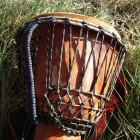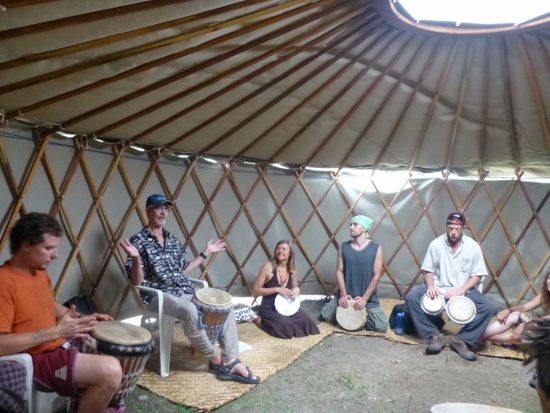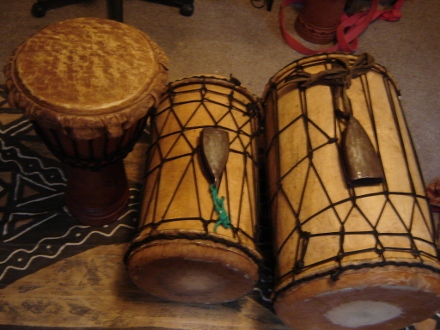Introduction to djembe beats & technique, vocabulary & written notation
A universal language
West African drumming has become a kind of universal language around the world. Originating in Guinea and neighboring countries of the former Mali empire, the rhythms of the djembe (jembe) and dununs (dunduns) can now be heard everywhere.
If you travel with a djembe you will find others to jam with, and sharing drum rhythms will lead quickly to new friendships. If you are skilled there will be chances to perform with other drummers, to teach drum lessons, to drum for dance classes, and to sit in with bands of many kinds needing hand drums and percussion.
Learning West African drum rhythms
Some people find it easy to learn by listening and copying new drum patterns by ear and feel. For others it helps to have a visual reference with written notation for djembe rhythms and dunun parts.
West African polyrhythms can be quite complex, not only with interlocking notes of the basic parts, but also with djembe solo phrases and dunun variations. The collected tradition of West African drum rhythms is vast, so it helps the memory to have a written book of notation sheets for handy reference and study. With smart phones and tablets, referencing your collection of drum rhythms becomes even more convenient.
Basic vocabulary of the West African drum language
The language of the West African drums, the djembe and dununs (with attached bells if played in the traditional way), can be learned with a simple vocabulary of a few basic beats.
Basic djembe beats & notation
For the djembe, the primary notes are bass, tone and slap. You can mimic these sounds by saying, “Gun, go, Pa.”
Since we play djembe with both hands, let’s use the above for the right hand, and call the left-hand version, “Dun, do, Ta.”
Playing all these notes on alternate hands (R, L) then produces a rhythm that rolls off the tongue:
Pa Ta go do Pa Ta Gun Dun
See YouTube video on basic djembe technique and vocabulary.
To notate this rhythm with equal spacing, we just use the first letter, like so:
P T g d P T G D
(Capital letters indicate the more dominant notes, slaps or bass notes, and allow us to distinguish “go/do” from “Gun/Dun.”) Since we know what the letters mean, when we read and play the above pattern in shorthand notation, we can still say the whole words, “Pa Ta go do Pa Ta Gun Dun.”
When we use pauses in the timing of the rhythm, rather than playing every note, we’ll drop some of the notes and substitute rests (-). Let’s drop the bass beats, and repeat the above phrase using the same timing of eight notes. We end up with:
P T g d P T – – P T g d P T – –
The so-called “box notation” system gives us a visual aid to the timing:
That’s all there is to it. You can now read, write and remember any basic djembe rhythm using the above notation system.
See the full rhythm notation system with examples
Basic Dunun beats
For the dununs, the drum beats can be open (O) or muted (M), and are struck with an accompanying bell note; bell notes (x) also mark time when no dunun beats are struck.
Here’s a simple dunun pattern that illustrates all three kinds of notes:O – x – M – x
Again, with this simple notation you can access virtually any dunun rhythm.
Djembe Technique
For beginners and experienced djembe players alike, the first work is to improve your technique – the quality of distinctive sounds separating the tone and the slap. The tone is hit with the middle part of the fingers and produces a full, woody sound; the slap is hit with the fingertips and produces a sharp, cracking sound. It is sometimes taught by master drummers that the best way to produce the desired beat is simply by “thinking” it as you play. Whatever your method, practicing technique is the surest way to improve as a drummer. Your mastery of it will never be done, but you will get better!
See free djembe lessons (YouTube videos) on technique, also basic accompaniment parts in 4/4 and 6/8.
If
you have any questions or comments, please feel free to email
me.
in the meantime, happy drumming!
– Nowick Gray
![]()
 |
 |
 |
 |
Save $$ on Roots Jam rhythm books and audio (digital formats) — Order combo bundles direct from this site.
 |
 |
 |


